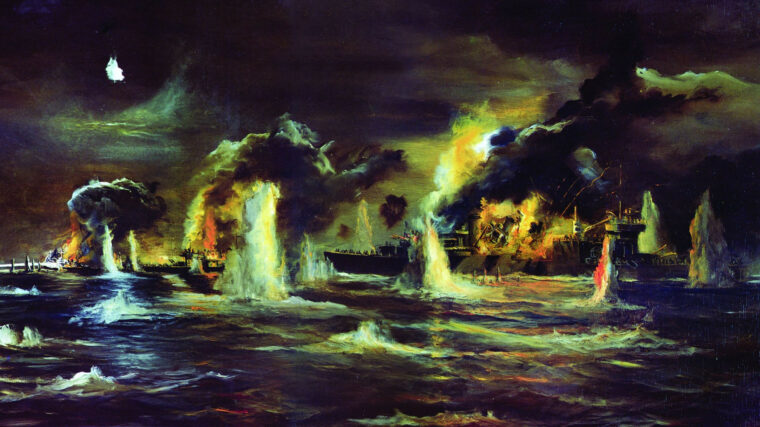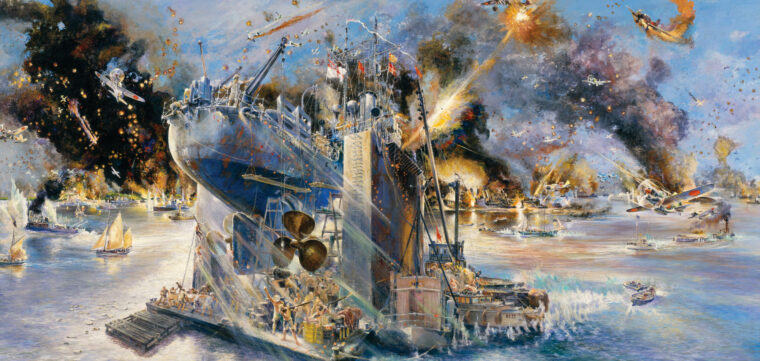
WWII
Combat Horror On Saipan
By David H. LippmanIn the high summer of 1944, the United States was coiling a massive fist in the Central Pacific aimed directly at the Mariana Islands, specifically Saipan, Tinian, and Guam. Read more


WWII
In the high summer of 1944, the United States was coiling a massive fist in the Central Pacific aimed directly at the Mariana Islands, specifically Saipan, Tinian, and Guam. Read more

WWII
A United States naval task force bearing the U.S. 1st Marine Division arrived off Guadalcanal, in the eastern Solomon Islands, on the morning of August 7, 1942, and launched the first American offensive operation of World War II. Read more

WWII
In German it was called Operation Rösselsprung, which translates to “Long Jump.” Its goal was to kill or kidnap the Allies’ “Big Three” leaders––Soviet Premier Josef Stalin, British Prime Minister Winston S. Read more

WWII
Joseph J. Foss (April 17, 1915–January 1, 2003) was born on a farm near Sioux Falls, South Dakota. Read more

WWII
On February 1, 1943, a group called the U.S. Army Signal Intelligence Service, the forerunner of the modern-day National Security Agency (NSA), began a project to intercept and analyze diplomatic signal traffic sent by an ally of the United States: the Soviet Union. Read more

WWII
By mid-September 1944, the U.S. Third Army was poised to strike at the soft underbelly of Adolf Hitler’s Third Reich along a fabled corridor in northeastern France used for centuries by armies tramping across Europe. Read more

WWII
“Banzai! Banzai!” screamed the Japanese at the top of their lungs as they launched a ferocious night attack against Marines dug in on Guadalcanal. Read more

WWII
The portion of the Siegfried Line guarding the Saar industrial region of Germany proved a sinister gateway into western Germany for Lt. Read more

WWII
The world was understandably shocked when France capitulated to Nazi Germany in June 1940, but not all Frenchmen accepted their country’s humiliation. Read more

WWII
On June 7, 1944, D+1, two volunteer Canadian 3rd Division, 9th Infantry Brigade regiments, the North Nova Scotia Highlanders (the North Novas) and the 27th Canadian Armoured Regiment (the Sherbrooke Fusiliers)—together with volunteer units from the Camerons of Ottawa and Forward Observers from the 14th Field Regiment—fought an important but now generally forgotten battle in Normandy. Read more

WWII
On October 6, 1943, Dr. Albert Speer, Reich minister of armaments and war production for the Third Reich, gave a 50-minute address to the assembled top officials of Nazi Germany at Posen Castle in occupied Poland’s Reich Gau (Region) of Wartheland on the critical state of World War II at that point. Read more

WWII
As militarism grew in Japan in the early 1930s, conscription began at the age of 19, and the Imperial Japanese Army (IJA) cadet entered military service. Read more

WWII
The Ninth Air Force began life on August 21, 1941, as the 5th Air Support Command at Bowman Field, Kentucky, and was activated on September 1, 1941. Read more

WWII
At the start of World War II, Japanese airpower ruled the skies over China and the Pacific. Read more

WWII
Lieutenant General George S. Patton, Jr., the commander of the newly constituted U.S. Third Army, had one simple order that late summer of 1944: “Go east and go like Hell.” Read more

WWII
It was with great anticipation that I sprang up the snowy steps of a Milwaukee building in January 1942 and entered the Marine Corps Recruitment Center. Read more

WWII
By the mid-1930s many people in Australia were concerned that if war came to Europe that Great Britain would not be able to come to their defense against a growing and aggressive Japanese Empire. Read more

WWII
Wing Commander Guy P. Gibson of Royal Air Force Bomber Command was handed the most challenging assignment of his six-year career in the spring of 1943. Read more

WWII
The sun was just rising and the day promised clear skies overhead. Since 5 am maintenance crews had been running the engines, making last minute adjustments, and arming the scores of aircraft sitting on the steel flight deck of the Japanese aircraft carrier Akagi. Read more

WWII
Noted chronicler of the Pacific Theater Eric Hammel recently spent three years sorting, scanning, cleaning, selecting, and captioning United States Marine Corps World War II photos for six pictorial books. Read more